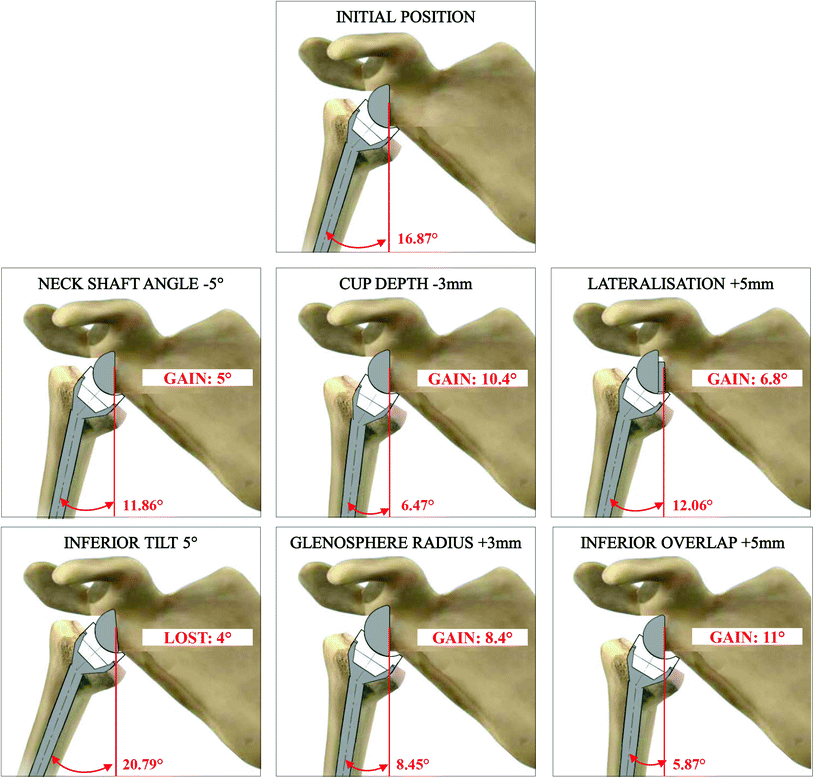Fig. 33.1
Grammont reverse concept
These concepts, developed from the experience of DELTA CTA, were the foundation for the development of DELTA XTEND.
Center of Rotation on the Glenoid Bone: Long-Term Fixation
Based on Professor Grammont’s experience, the safest glenoid design which can guarantee long-term fixation is a glenosphere with the center of rotation on the glenoid bone. It avoids the development of a lever arm that creates shear forces, generating a rocking horse phenomenon on the glenoid implant which can potentially lead to glenoid loosening. Moreover, the medialization of the humerus is allowing a rotation of the humeral component around the glenoid implant without a conflict between the humerus and the acromion [2].
Neck-Shaft Angle of 155°: Joint Stability
This neck-shaft angle has also been defined following the clinical background of the DELTA CTA. Professor Grammont defined from his experience the best balance between stability and scapular notching is a 155° humeral neck-shaft angle (the bigger the neck-shaft angle is, the better the stability offered, the smaller the neck-shaft angle is, the less potential for notching) [2].
Humeral Epiphysis Inside the Humerus: Less Deltoid Over-Stretching
The reverse epiphysis is placed inside of the humerus, a design feature that limits the lowering of the humerus, and therefore limits the overstretching of the deltoid. This prevents an increase of the forces on the glenoid component and provides the opportunity for long-term fixation.
DELTA CTA—Improving on 15 Years of Clinical Experience
The goal of the DELTA XTEND project was also to take into account the 15 years of clinical experience of the DELTA CTA [4], while also providing important improvements to the prosthesis:
Improvement of the rate of scapular notching (due to the reverse shoulder concept): (see Sect. “Scapular Notching Improvement”)
Design optimization (see Sect. “Design Optimization: (Fig. 33.3)”)
Provide the possibility to mix any glenoid size with any humeral size
Offer a metaglene with a curved back surface (preserving the glenoid bone stock and increasing the fixation)
Development of locking, adjustable, and compressive metaglene screws allowing for strong fixation of the metaglene and offering the surgeon more options in the selection of screw positioning (secured by the cannulated screw design)
Offering an eccentric humeral epiphysis in order to preserve the anterior cortical bone
Improved design features for fracture indications
Introduction of long peg metaglenes for revision cases
Scapular Notching Improvement
In order to have a complete understanding of the scapular notching phenomenon, an interactive 2D biomechanical model was developed during the DELTA XTEND project. The goal of this model was to find which design parameter had the largest influence on the reduction of scapular notching in any scapula shape. This study included the following design parameters: (1) Humeral neck-shaft angle, (2) humeral cup depth, (3) lateralization of the center of rotation, (4) inferior tilt of the glenoid implant, (5) glenosphere radius, and (6) inferior glenosphere overlap (distance between inferior glenosphere edge and scapula horizontal neck). The authors concluded that inferior glenosphere overlap is the most effective way to prevent scapular notching [5] (Fig. 33.2).


Fig. 33.2
Notching study, most efficient parameter to reduce notching: inferior glenosphere overlap (on a worse case scapula shape)
Following the result of this biomechanical study and to prevent the scapular notching, the DELTA XTEND implant design offers different solutions to achieve an inferior glenosphere overlap:
A smaller metaglene diameter (27 mm) allowing the surgeon to position the metaglene axis lower.
Adjustable screws allowing the position of the metaglene to be lower on the glenoid bone and still keeping the inferior screw in the scapula pillar.
A bigger glenosphere diameter of 38 mm and 42 mm (instead of 36 mm for the DELTA CTA) which increase the inferior overlap of the glenosphere and reduce notching [6].
Stay updated, free articles. Join our Telegram channel

Full access? Get Clinical Tree








